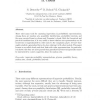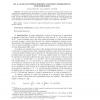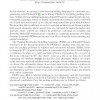493 search results - page 27 / 99 » Representing preferences using intervals |
ACMICEC
2006
ACM
14 years 1 months ago
2006
ACM
In this paper we have introduced a methodology to rank the available products in the Internet market. These rankings are based on the customers’ own preferences and also on the ...
IJAR
2008
13 years 7 months ago
2008
There exist many tools for capturing imprecision in probabilistic representations. Among them are random sets, possibility distributions, probability intervals, and the more recen...
SIAMCO
2000
13 years 7 months ago
2000
We study a class of functional which can be used for matching objects which can be represented as mappings from a fixed interval, I, to some "feature space." This class o...
JELIA
2004
Springer
14 years 1 months ago
2004
Springer
Abstract. Often, decision making involves autonomous agents that are structured in a complex hierarchy, representing e.g. authority. Typically the agents share the same body of kno...
CPAIOR
2009
Springer
14 years 2 months ago
2009
Springer
In this abstract, we present a rule-based modelling language for constraint programming, called Rules2CP [1], and a library PKML for modelling packing problems. Unlike other modell...



